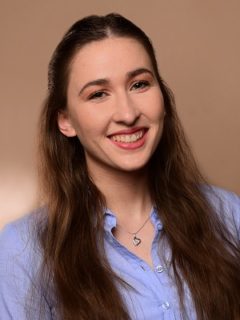Alexa Buck
Alexa Buck
Master student
Fabrication of biphasic constructs using melt electrowriting (MEW) and extrusion based 3D printing
Supervisor: Sonja Kuth, Prof. Aldo R. Boccaccini
Hydrogels, that are non-toxic, bioactive, and biodegradable, can be used to mimic the extra cellular matrix (ECM) to form tissue-like structures [1]. Polymers used for hydrogel processing are either components of the extracellular matrix or have similar macromolecular properties and therefore allow cellular interaction for tissue formation by providing a surrounding of endogenous signals [2]. Hyaluronic acid (HA) is a naturally derived polymer that is a component of the native ECM and therefore omnipresent in the human body [3]. Melt electrowriting (MEW) is an additive manufacturing technique to fabricate scaffolds made from fibers on a microscale using the biodegradable polyester poly(?-caprolactone) (PCL) [4]. By taking advantage of the mechanical support of PCL’s thermoplastic structure and the biological functionalization by the HA-hydrogel phase, the benefits of both phases can be combined in an advanced biphasic scaffold [5]. In this thesis, we aim to combine extrusion 3D printing of an HA-based hydrogel with melt electrowriting (MEW) to fabricate biphasic constructs for soft tissue engineering applications.
[1] R. Landers, A. Pfister, U. Hübner, H. John, R. Schmelzeisen, and R. Mülhaupt, “Fabrication of soft tissue engineering scaffolds by means of rapid prototyping techniques,” Journal of Materials Science, vol. 37, no. 15, pp. 3107–3116, 2002, doi: 10.1023/A:1016189724389.
[2] H. Tan and K. G. Marra, “Injectable, biodegradable hydrogels for tissue engineering applications,” Materials, vol. 3, no. 3, pp. 1746–1767, 2010, doi: 10.3390/ma3031746.
[3] J. A. Burdick and G. D. Prestwich, “Hyaluronic acid hydrogels for biomedical applications,” Advanced Materials, vol. 23, no. 12, 2011, doi: 10.1002/adma.201003963.
[4] J. C. Kade and P. D. Dalton, “Polymers for Melt Electrowriting,” Advanced Healthcare Materials, vol. 10, no. 1, 2021, doi: 10.1002/adhm.202001232.
[5] T. Zehnder, T. Freund, M. Demir, R. Detsch, and A. R. Boccaccini, “Fabrication of cell-loaded two-phase 3D constructs for tissue engineering,” Materials, vol. 9, no. 11, 2016, doi: 10.3390/ma9110887.

